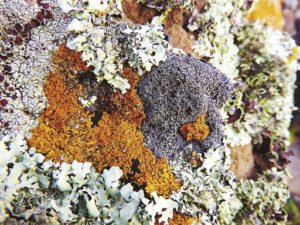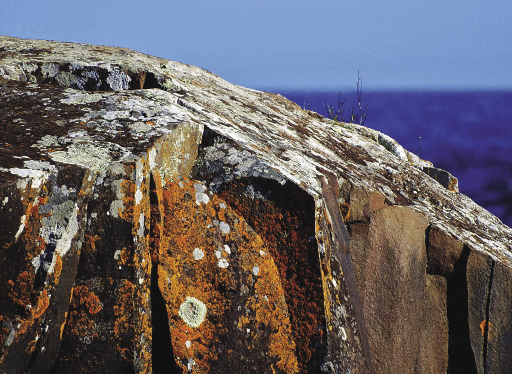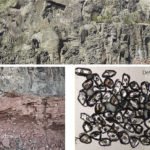Grand Marais—In early winter, when the sky, the trees, and your mood all turn gray, it’s time to head to the lake. The shore of Lake Superior is always a source of beauty, solace and adventure, but—if you know where to look—it also hosts inspiring teamwork and fierce competition to rival Sunday’s game.
Crusts of lichens splash rainbows onto smooth gray basalt and rhyolite ledges all along the North Shore. Orange, yellow, gray and green are the most common colors for these remarkable teams. Lichens aren’t a single organism; instead they are a tiny troop of organisms living together in a symbiosis.
We used to think that lichens were simply a fungus and an alga (or cyanobacteria). The fungal partner provides the structure and the anchor that holds both to the rock, and the algae, live inside the fungal matrix doing photosynthesis and making sugar for them both. Without algae, the fungus couldn’t find anything to eat on the bare rocks it inhabits. Even on trees and soil, lichens simply anchor and don’t feed. Without the fungus, the algae would dry up and blow away.
More than 25,000 types of lichens can be found worldwide. Together, they are durable enough to colonize the most extreme habitats on earth—mountains, deserts, abandoned cars—and survive at least 14.6 days in the vacuum of space. Yes, a lichen became an astronaut.

One of the ways lichens survive adversity is to surrender to it. Their thalli (leaf-like structures) gain and lose water as the relative humidity fluctuates. During dry spells, whether hot or cold, a lichen thallus might only contain 15-30 percent water, and it goes dormant. Freezing temperatures don’t seem to bother lichens and at least one species can photosynthesize down to -4 degrees F. On mild, damp days, moisture seeps back into their cells, the surface becomes translucent and photosynthesis resumes within minutes. This is when the unique team that is a lichen looks its best.
And now, through the acquisition of new knowledge, the lichens’ roster just got bigger. Scientists recently discovered that species of a second, unrelated type of fungus—single-celled yeasts—live in the outer cortex of many lichens’ thalli. These yeasts help produce chemicals that ward off predators and repel microbes. Indeed, the team extends even further. It includes a poorly studied community of bacteria that live inside the lichen and may help the other players acquire nutrients like nitrogen, phosphorus and amino acids.
When these diverse players come together on teams, they paint the town—and rocks—with an incredible diversity of colors and patterns that anyone can enjoy. While individual lichens are textbook examples of teamwork in nature, people who know how to look are privy to a relentless world of rivalries on the rocks.
Next time you brave the icy wind and crashing waves to visit a lichen-covered rock, look a little closer. From roughly circular, to sinuous lines, to misshapen blobs, a mosaic of shapes and colors resembling a map of the world appears. And if you look even closer, the boundaries between these territories reveal winners, losers, and ties.

In one area, you may find a cluster of round, gray, crustose (held tight to the rock) lichens outlined in black. The dark ring is the fungal front line, tentatively exploring new territory before it brings the family along. Where neighbors meet, the two may compete and one will overgrow or push back the other. They might call a truce, and grow in different directions. Or, if they are compatible “mating types” (fungi don’t have sexes) they may grow together and combine genetic material. Meanwhile, some tiny flecks of yellow crustose lichens seem to avoid conflict by nestling into the cracks.
On the periphery of the crustose lichens, invading foliose lichens stealthily extend their thalli outward, shading the low-profile pioneers and taking over their space (at a snail’s pace of 1-5 mm per year). The brilliant orange Elegant Sunburst lichen is a common interloper, and a favorite of photographers. But even its compact thalli sometimes succumb to the pale green offensive of the more overbearing Rock Shield lichens.
Green growing over orange, orange creeping in on gray, gray holding its own against yellow…to enjoy the drama, you don’t even need to identify the lichens’ species as long as you can tell them apart.



